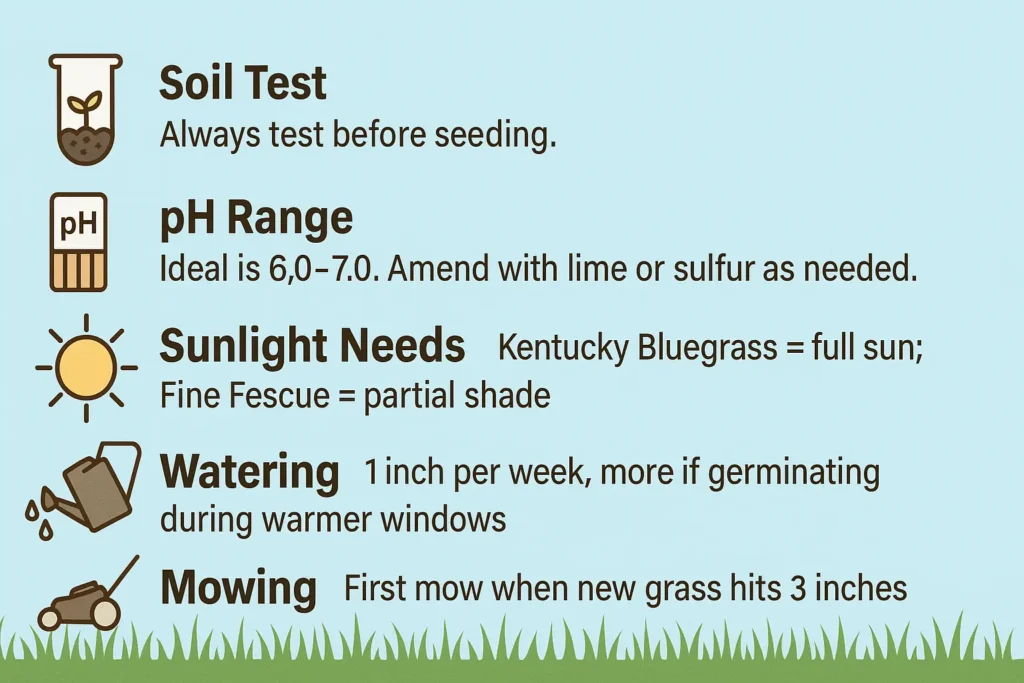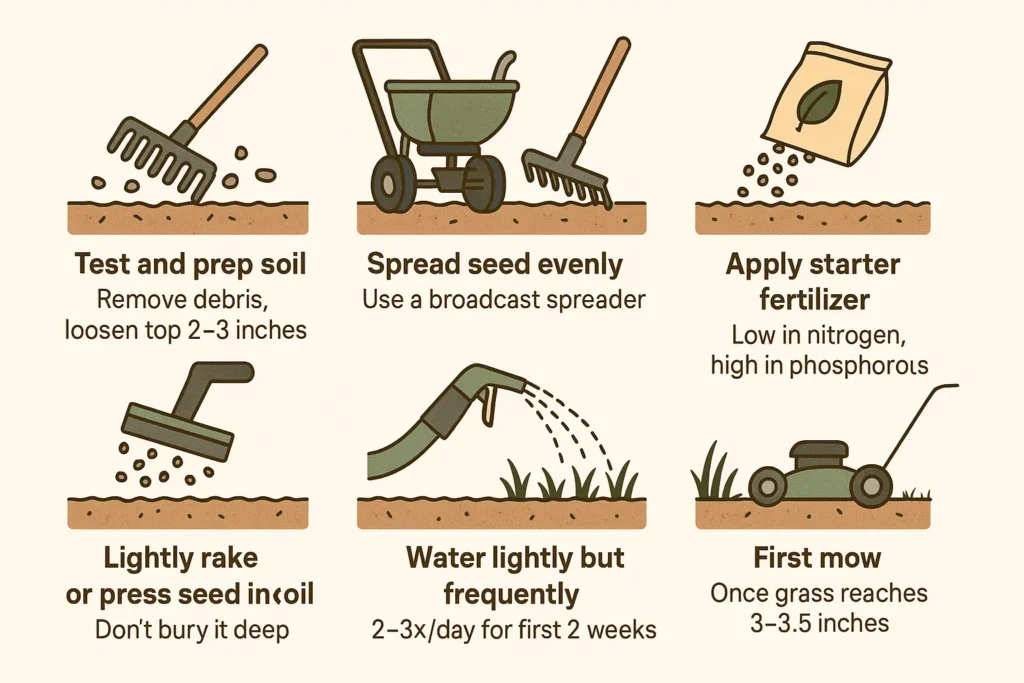When to Plant Grass Seed in Pennsylvania: Complete Guide for Every Lawn Type

Planting a lush, healthy lawn in Pennsylvania isn’t just about what kind of grass you choose—it’s about when you plant it. If you’ve been wondering when to plant grass seed in Pennsylvania, this guide breaks it down by region, season, grass type, and growing zone. Whether you live in the Pittsburgh hills or the Philly suburbs, this is your complete playbook for lawn success.
Best Time to Plant Grass Seed in Pennsylvania
Fall is the best time to plant grass seed in Pennsylvania. From late August to early October, soil temps are ideal, weeds are fading, and roots have time to establish before winter. Spring is a solid backup window, but comes with more temperature swings and weed competition.
Here’s a quick breakdown of when to plant grass seed in Pennsylvania:
- Fall: August 15 – October 10
- Spring: April 1 – May 15
- Dormant Seeding (advanced): November after the ground freezes
Why fall? Cooler temps and consistent rainfall help seeds stay moist and germinate properly—without the intense weed pressure or heat stress of summer.
Pennsylvania Hardiness Zones
Understanding your USDA hardiness zone is key to picking the right seed and planting time. Pennsylvania ranges from Zone 5a in the north to Zone 7a in the southeast.
Zone: 5a–5b
Region: Northern & Central PA
Best Grass Types: Fine Fescue, Kentucky Bluegrass
Zone: 6a–6b
Region: Harrisburg, Scranton
Best Grass Types: Tall Fescue, Perennial Rye, Bluegrass
Zone: 7a
Region: Philadelphia area
Best Grass Types: Tall Fescue, Heat-tolerant Bluegrass blends
Knowing your zone ensures you’re planting grass that can withstand your local winter temps and growing season. It also influences how early or late in the year you should seed.
🔍 Not sure what zone you’re in? You can look up your zone here.
Best Grass Seed for Pennsylvania Lawns
Choosing the right seed is just as important as timing. Since Pennsylvania is a cool-season climate, you’ll want grass types that thrive in spring and fall, and hold up through cold winters.
Kentucky Bluegrass
Popular for its rich green color and fine texture, this grass type spreads by rhizomes, making it ideal for filling in patchy areas. Best for full-sun lawns.
Tall Fescue
Heat and drought-tolerant, Tall Fescue is great for southern PA and lawns with heavy foot traffic. It’s also more shade-tolerant than Bluegrass.
Perennial Ryegrass
Quick to germinate and great for overseeding, this grass does best in well-drained soils with good sun exposure. It pairs well with Bluegrass in mixed lawns.
Fine Fescue
Shady backyard? Fine Fescue is your best bet. It’s low-maintenance, does well in partial shade, and can tolerate cooler temps.
If you’re deciding when to plant grass seed in Pennsylvania, choose your seed first—it affects when you should start planting.
Seasonal Guide: Planting Grass Seed in Pennsylvania
Spring
- Timing: April 1 – May 15
- Conditions: Unpredictable weather; soil must reach 50–65°F
- Best for: Quick fixes or bare spots
Fall (Best)
- Timing: August 15 – October 10
- Conditions: Stable temps, fewer weeds, consistent rain
- Best for: Full-lawn seeding, overseeding, establishing new lawns
Summer
- Not ideal. High heat and dry spells make germination difficult. If you must, use drought-tolerant seed like Tall Fescue and water daily.
Winter (Dormant Seeding)
- Seed after the ground freezes (late Nov–Dec) to let seed sit dormant and germinate naturally in early spring. Works best with Fine Fescue.
If you’re still unsure when to plant grass seed in Pennsylvania, check your soil temperature—it should be consistently above 50°F for successful germination.
Soil, Water & Sun Tips for PA Lawns
Even the perfect timing won’t help if your soil or watering schedule is off. Here’s how to set your lawn up for success:
- Test your soil: Many areas of PA have acidic soils; amend with lime if pH < 6.0.
- Aerate before seeding: Especially in clay-heavy or compacted yards.
- Water lightly, daily: For the first 2–3 weeks post-seeding.
- Sun matters: Bluegrass and Rye need full sun; Fine Fescue tolerates shade.
The question of when to plant grass seed in Pennsylvania always includes: “Is my soil ready to support it?”
Common Mistakes to Avoid
Timing mistakes are common—but fixable. Avoid these:
- Seeding in summer without irrigation
- Using warm-season grasses like Bermuda (they’ll die over winter)
- Planting too early in spring (frost can kill seedlings)
- Letting soil dry out during germination
If you’ve failed before, it may not be the seed—it might just be the wrong window.
Step-by-Step: How to Plant Grass Seed in Pennsylvania
- Rake and loosen the soil (remove debris and dead grass)
- Test and amend soil (add lime, compost, or starter fertilizer as needed)
- Spread seed using a handheld or rotary spreader
- Lightly rake or roll seed into soil
- Water daily until grass reaches 3 inches
- First mow at 3–3.5 inches
By now, you’re not just asking when to plant grass seed in Pennsylvania, but how to do it right. Follow this sequence and you’ll see thick, green growth within 10–21 days (depending on the seed).
Regional Tips by Area
Pennsylvania is diverse. Here’s how to adapt by location:
Western PA
Cold winters; start early in fall.
Central PA
Ideal for Ryegrass blends; great fall window.
Southeastern PA
Mild winters; fall planting can go into October.
Northeastern PA
Shorter growing season—avoid late seeding.
These local nuances matter as much as the actual date on the calendar. That’s why understanding when to plant grass seed in Pennsylvania includes knowing your microclimate.
Explore More Lawn Tools & Calculators
Need help choosing a seed blend or planning your watering schedule? We’ve got tools to make lawn care easier:
- ✅ Grass Seed Calculator
- ✅ Lawn Fertilizer Calculator – Apply the right amount of nutrients based on lawn size and grass type
- ✅ Lawn Mowing Cost Calculator – Estimate mowing expenses by lawn size, frequency, and contractor pricing
- ✅ Lawn Care Cost Calculator – Budget for overseeding, watering, fertilizing, and more
When it comes to knowing when to plant grass seed in Pennsylvania, these tools help you go from guesswork to precision.
Expert-Backed Reference
Want scientific evidence on seeding practices? Check out this summary by Conservation Evidence, which outlines research-backed recommendations on sowing grass seed across climates and soil conditions. It’s a great resource for gardeners who want to go beyond anecdotal advice.
Final Takeaway: When to Plant Grass Seed in Pennsylvania
So, let’s bring it all home.
- Best time: Fall (Aug 15 – Oct 10)
- Backup window: Spring (Apr 1 – May 15)
- Best grasses: Kentucky Bluegrass, Tall Fescue, Perennial Ryegrass, Fine Fescue
- Prep matters: Test your soil, aerate, water consistently
Understanding when to plant grass seed in Pennsylvania is about aligning your lawn care routine with the rhythms of the region. Get the timing right, and everything else becomes easier.
👉 Don’t forget to explore our full guide:
🔗 Best Time to Plant Grass Seed Guide
Whether you’re in Erie, Harrisburg, or the Philly burbs—now you know exactly what to do, and when.


